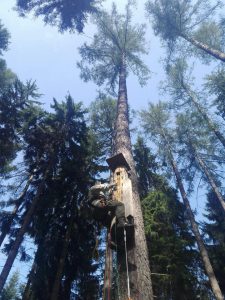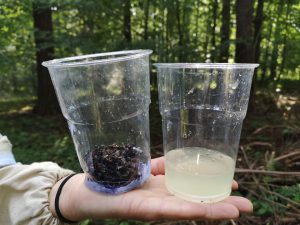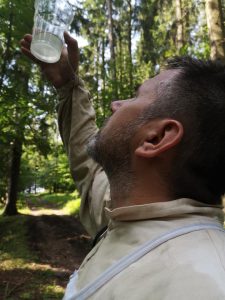Monitoring
The purpose of monitoring is to determine how many bee logs are inhabited by bees and to keep a register of the location of bee logs. At the same time, bee colonies are assessed for their health and possible preventive measures are taken to eliminate pathogenic factors.
As the basis for monitoring, we adopted the assumption that bees in the forest live without human intervention in the sense that they do not receive their collected food and do not interfere in their biology. The only invasive procedure is to prevent the development of a bee hive (Varroa destructor) by monitoring the degree of alcohol infestation, and in the event of disease symptoms, actions are taken to control mites by methods such as organic beekeeping. The entire project is supervised by the Poviat Veterinary Inspectorate.
MONITORING 2018
a) In 2018, Monitoring of Beech Logs covered 479 positions – this number results from the status of hung logs as of July 15, 2018
b) Spontaneous colonization by honey bees was found in 6 sites
c) No bee pest infestation was detected
d) 11 colonizations by other Hymenoptera and 1 by a black woodpecker were recorded
MONITORING 2019
a) In 2019, Monitoring of Beech Logs covered 1,000 positions divided into two parts: spring and summer. This is due to the fact that the assembly of bee logs is being completed this year. b) Spontaneous colonization by honey bees was confirmed: in 9 sites in spring (4 sites were overwintered in 2018); in 12 positions in the summer
c) No bee pest infestation was detected
d) 69 colonizations by other Hymenoptera and 9 by birds, including the black woodpecker, were recorded
MONITORING 2020
a) In 2020, Monitoring of Beech Logs covered 1,000 positions.
b) Spontaneous colonization by honey bees was confirmed: in x sites in spring (where x sites are overwintered from 2019); in x positions in summer
c) No bee pest infestation was detected
d) 10 colonizations by other Hymenoptera and birds, dormouses, ants and dormouse were found.
MONITORING 2021
a) In 2021, Monitoring of Beech Logs covered 1,000 positions. b) Spontaneous colonization by honey bees was confirmed: in 10 sites in spring (where x sites are overwintered from 2020); in 19 positions in the summer
c) No bee pest infestation was detected
d) Inhabitation by other Hymenoptera and birds, dormouses, ants, dormice and bats was found.
MONITORING 2022
a) W roku 2022 Monitoring Kłód Bartnych obejmował 1000 szt stanowisk.
b) Stwierdzono samoistne zasiedlenie przez pszczołę miodną: w x stanowiskach na wiosnę (przy czym x stanowiska to przezimowane z 2021); w x stanowiskach latem
c) Nie stwierdzono porażenia dręczem pszczelim.
d) Stwierdzono zasiedlenia przez inne błonkoskrzydłe, osy, szerszenie; ptaki, koszatki, mrówki, popielice, nietoperze.
MONITORING 2023
a) W roku 2022 Monitoring Kłód Bartnych obejmował 1000 szt stanowisk.
b) Stwierdzono samoistne zasiedlenie przez pszczołę miodną: w 6 stanowiskach w lecie (przy czym 9 to stanowiska z roku ubiegłego, które przezimowały)
c) Nie stwierdzono porażenia dręczem pszczelim.
d) Stwierdzono 221 zasiedleń przez inne błonkoskrzydłe (szerszeń), 4 zasiedlenia przez osy, 4 przez nietoperze, pozostałe to kuna, koszatka, popielica i ptaki.





